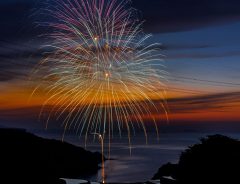- Source:
- Chiura Obata / Japaaan
Related Article
-

Capsule toys of concerned animals weighing themselves for life goals released in Japan
-

Kyoto Cafe Offers Healthy Vegan And Vegetarian Dishes Using Ingredients Straight From The Farm
-

Seller Thinks He’s Ripped Off Japanese YouTuber With $3 Rusty Knife, Definitely Regrets It After This DIY Restoral
-

Japan Has A Robot Vendor That Is Very Happy To Give You Ice Cream
-

“I finally got it!” Fireworks reflected on famous rice terrace in Japan are truly spectacular
-

Japan opens up chiropractic service for gamers with bad posture



To say that the artwork of Chiura Obata (1885-1975) is an artistic reflection of his bicultural identity does not seem too much of a stretch, as his American landscapes fuse intricately with the Japanese-style painting techniques in which he was a master.
Obata, who started painting with sumi (ink) at the age of 7, displayed artistic talent from an early age. At 14 he began apprenticing under the famous Japanese painter Tanryo Murata, but decided to immigrate to America four years later to learn more about the western world.
He worked as an illustrator for Japanese publications in San Francisco, but his career took a turn after he was invited by Worth Ryder to Yosemite for a sketching trip. Falling in love with the scenery, he went back to every year until his death, and Yosemite eventually became the model for many of his famous works.
Having experienced living in the internment camps during World War Two, Obata proactively made efforts to introduce American to the aesthetics of Japanese art, and strived to create mutual understanding between the two cultures to prevent future conflicts. And these efforts were not in vain — in 1965 he was awarded the Emperor’s Medal in Tokyo for his contributions in promoting understanding between Japan and the United States.
Lake Basin in High Sierra
Source: Chiura Obata
Setting Sun in the Sacramento Valley
Source: Chiura Obata
Full Moon, Pasadena, California
Source: Chiura Obata
Morning at Mono Lake
Source: Chiura Obata
Death Grave's Pass and Tenaya Peak
Source: Chiura Obata
Evening Glow, Mono Lake
Source: Chiura Obata
Eagle Peak Trail
Source: Chiura Obata
Evening Moon
Source: Chiura Obata
Dana Creek
Source: Chiura Obata
Silent Moonlight at Tanforan Relocation Center
Source: Chiura Obata
Evening Glow at Lyell Fork, Tuolumne Meadows
Source: Chiura Obata
Before the Rain, Mono Lake
Source: Chiura Obata